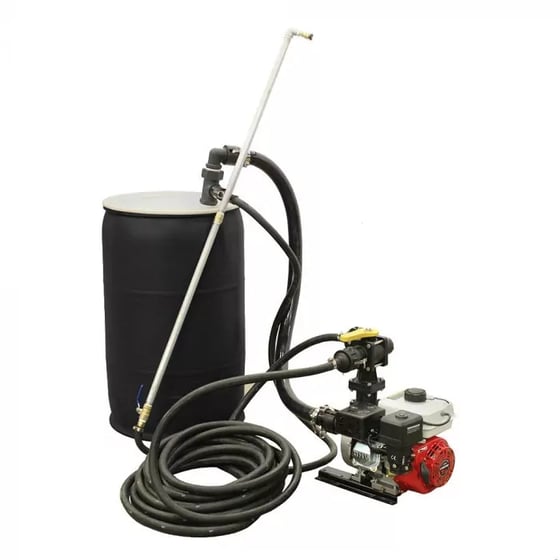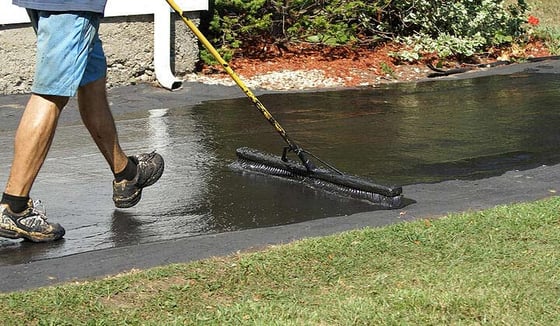Key Points
- Regular and timely asphalt parking lot maintenance is a crucial aspect of prolonging the lifespan of your pavement asset.
- Discover different asphalt maintenance tools and equipment.
- Get a comprehensive and easy-to-follow parking lot maintenance checklist.
Do you own or manage a shop, restaurant, or other commercial property? Chances are you take great pains to keep the interior clean and flawless.
But you haven't really focused on parking lot maintenance. Perhaps you haven't had your parking lot sealed in years, and there are a few cracks all over the area. Often, maintaining your parking lot is an afterthought. Something that you have to do when you see major damage on your asphalt.
But there are so many benefits in investing in regular parking lot maintenance, and we're going to discuss them here. We'll also talk about the different parking lot maintenance equipment and materials you'll need. Let's get started.
Table of Contents
- Why Perform Routine Parking Lot Maintenance and Repair?
- Parking Lot Maintenance Investments
- Must-Have Asphalt Maintenance Equipment and Tools
- Comprehensive Parking Lot Maintenance Checklist
- Asphalt Parking Lot Maintenance Guidelines
- Parking Lot Maintenance Costs
- Creating an Effective Parking Lot Maintenance Plan
- Frequently Asked Questions
Why Perform Routine Parking Lot Maintenance and Repair?
Regular Asphalt Maintenance Improves First Impressions
When someone drives up to your business, the parking lot is the first thing they see. It also contributes to whether or not your business gives off a good first impression. Parking lot maintenance ensures that the impression is positive just as much as painting the building does.
Additionally, no one wants the customer's first impression to be bouncing their vehicle along potholes as they try to find a space. That would leave a negative impression, and the customer may even subconsciously avoid the lot.
Maintain Parking Lots for Improved Aesthetics
If you invest in your parking lot, it will enhance any other branding completed for the business. For example, your business might offer luxury products and a tailored customer experience. A well-kept parking lot enhances that perception.
Boost Parking Lot Conditions and Safety
One of the big reasons to invest in your parking lot maintenance involves safety. Potholes and cracks are tripping and twisted-ankle hazards.
Additionally, maintaining a parking lot carefully also assists vehicles. Vehicles can damage axles or lose alignment in potholes or by running into ill marked curbs. By doing parking lot maintenance, you can avoid these expenses.
Regular Cleaning and and Preventative Maintenance Prolong Asphalt Lifespan
Performing parking lot maintenance can also extend the life of your lot. The maintenance, including cleaning, crack sealing, sealcoating, and more, means that your lot is subject to less water damage over time. That protects your investment and means a delay in having to replace the parking lot.
Is your parking lot still in tip-top shape? Take this short asphalt assessment to see if it's time to fix those cracks or seal your pavement.
Parking Lot Maintenance Investment
Cleaning a parking spaces – whether it's located in an airport or hospital – serve two purposes. First, asphalt cleaning and snow removal improve the aesthetics. Second, you can check your parking lot for potential problems. Tools like the Bensink Rotary Broom make the process of cleaning and snow removal simple and easy for you.
See the Bensink Rotary Broom in Action
You can also contract the work out to a parking lot maintenance contractor. Many asphalt maintenance companies are willing to clean up parking areas for a reasonable fee. They'll even check your parking lot over for problems. Plus, they have parking lot maintenance workers so you don't need to do all that back-breaking work.
Pothole Repair
Potholes are a common parking lot headache. This is especially true if your business is built in an area where it frequently freezes. The water freeze/thaw cycle just keeps making them bigger. Pothole repair stops these hazards from becoming ponds in your parking lot.
Pothole repair techniques depend on the size and depth of the pothole. Generally, hot patching is a better choice, even though cold patching is more feasible with winter temperatures. In either case, the sooner potholes are caught and repaired, the better.
Crack Filling
Crack filling is necessary for those long, shallow problems. This asphalt parking lot maintenance activity requires a bit of know-how, but you can do it yourself if you desire. By filling the cracks, you prevent them from spreading further.

Keeping track of your parking lot cracks during maintenance can also tell you when parts of your lot need further attention. For example, an area that always seems to have new damage may have a foundation issue.
Sealcoating
The good news is sealcoating can revitalize your parking lot asphalt. It applies a fresh layer to your lot, which delivers the oils necessary for healthy asphalt. Regular maintenance by sealcoating also adds a layer of protection from the elements that older asphalt lacks.
Do you manage multiple parking lots or own a vast parking space? If so, then buying a seal coating machine is a good decision. But if you own a small lot, then it may be cheaper to outsource this task rather than buying the equipment. It would likely sit idle most of the time if you bought equipment for a smaller lot.
Other Repairs
Asphalt comprises just one part of your parking lot and there are more areas you have to consider. The curbs, planters, and parking stops also may require repairs as each wears down. Some have simple fixes, like making sure you have a watering schedule or that you remove debris regularly. Other repairs are more complex, like repairing curbs.
These repairs also help with the overall aesthetics of your clean parking lot. These aesthetics are essential, regardless of whether you're supporting outdoor dining or drive-through farmer's markets.
Related: What is Bitumen: From Its Origins to Refined Asphalt Binder
Must-Have Asphalt Maintenance Equipment and Tools
When it comes to parking lot maintenance, the adage "a stitch in time saves nine" holds true.
Proper and regular maintenance can extend the life of your asphalt parking lot, ensuring it remains a welcoming feature for any property owner, including small businesses.
As part of a comprehensive maintenance program, there are specific tools and equipment that are indispensable. Let's delve into the must-haves.
Sealcoating Equipment. A sealcoating machine is a piece of equipment used to apply a protective sealcoat to asphalt surfaces like parking lots and driveways.

AK55 Sealer Sprayer for Drums
The machine typically consists of a tank or drum to hold the sealcoat material, a pump to transfer the material to the application tool, and a spray wand or brush for application.
Crack Sealing Machine. A crack sealing or filling machine is a piece of equipment used for filling cracks in asphalt and concrete surfaces. It usually consists of a heating unit to melt the crack filler material and a pump or applicator to fill the cracks.
Power Broom. A power broom is a mechanized broom designed to clean surfaces quickly and efficiently. It typically consists of a rotating brush powered by a gasoline or electric engine. The brush can sweep debris, loose aggregate, and other materials from surfaces like asphalt, concrete, and turf.
Line Striping Machine. A line striping machine, also known as a line painting machine or line marking machine, is a piece of equipment used to apply paint or thermoplastic markings on roads, parking lots, and other surfaces.
The machine typically consists of a paint container, a pump to transfer the paint, and a nozzle or applicator that applies the paint in a controlled and precise manner. Some advanced models also have guides or lasers to ensure straight and accurate lines.
Comprehensive Parking Lot Maintenance Checklist
✔️ Regular Cleaning
- Frequency: Regularly
- Tasks:
- Remove litter and debris
- Sweep the surface to remove dirt and loose material
✔️ Inspection
- Frequency: Every quarter
- Tasks:
- Check for cracks, potholes, or any signs of wear and tear
- Inspect the drainage system for blockages
- Examine the striping and markings for fading
✔️ Crack Filling
- Frequency: As needed
- Tasks:
- Clean out cracks from dirt and vegetation
- Fill the cracks with a suitable crack filler
✔️ Pothole Repair
- Frequency: As needed
- Tasks:
- Clean out the pothole of debris
- Fill the pothole with asphalt mix and compact it
✔️ Sealcoating
- Frequency: Every 2-3 years
- Tasks:
- Clean the surface thoroughly
- Apply a thin coat of sealcoat material
- Allow to dry completely before opening to traffic
✔️ Striping and Markings
- Frequency: As needed, typically every 1-2 years
- Tasks:
- Repaint lines and markings as necessary
- Ensure ADA compliance for handicap spaces
✔️ Landscaping
- Frequency: Regularly
- Tasks:
- Trim trees and bushes that border the parking lot
- Ensure that vegetation is not obstructing visibility
✔️ Drainage Maintenance
- Frequency: At least twice a year
- Tasks:
- Clean out any debris blocking the drainage
- Check for signs of water pooling or poor drainage
✔️ General Safety Check
- Frequency: At least once a year
- Tasks:
- Ensure all signs are visible and in good condition
- Check the condition of wheel stops and bollards
Remember, this is a general guide and the frequency and tasks may vary based on the usage and location of your parking lot. Regular maintenance will keep your parking lot safe, functional, and attractive to customers.
Asphalt Parking Lot Maintenance Guidelines
Maintaining your asphalt parking lot is essential for its longevity and safety. Here are some best practices and tips for addressing common issues.
Regular Inspections
- Why It's Important: Regular inspections can help you identify issues before they become major problems.
- What To Do: Schedule quarterly inspections to check for cracks, potholes, drainage problems, and faded striping.
Timely Repairs
- Why It's Important: Small cracks and potholes can quickly worsen, leading to costly repairs.
- What To Do: Address cracks and potholes as soon as they are noticed. Fill cracks with a suitable crack filler and repair potholes with an asphalt mix.
Preventive Measures

Applying asphalt sealer using a brush
- Sealcoating: Applying a sealcoat every 2-3 years protects the asphalt surface from water, oil, and UV damage.
- Crack Sealing: Regularly filling cracks prevents water from seeping into the base, which can lead to larger cracks and potholes.
- Proper Drainage: Ensuring proper drainage prevents water pooling and reduces the risk of potholes.
Parking Lot Maintenance Costs
Understanding the costs involved in parking lot maintenance is crucial for budgeting and long-term planning. Here's a simplified breakdown:
| Service | Cost |
| Parking Lot Cleaning | $50 to $200 per sweep |
| Sealcoating | $0.25 to $0.50 per square foot |
| Crack Filling | $1 to $3 per linear foot |
| Pothole Patching | $25 to $200 per pothole |
| Line Striping | $4 to $6 per line |
Cleaning
- Cost Range: $50 to $200 per sweep
- Factors: Frequency, size of lot, debris levels, type of business
- Why It's Important: Regular cleaning extends the life of your pavement and enhances aesthetics.
Sealcoating
- Cost Range: $0.25 to $0.50 per square foot
- Factors: Lot size, current condition, local labor rates
- Why It's Important: Sealcoating protects the asphalt, improving durability and lifespan.
Crack Filling
- Cost Range: $1 to $3 per linear foot
- Factors: Extent of cracking, material costs
- Why It's Important: Prevents water infiltration, reducing potential for major repairs.
Pothole Patching
- Cost Range: $25 to $200 per pothole
- Factors: Depth of potholes, total area requiring repair
- Why It's Important: Enhances safety and reduces liability risks.
Line Striping and Markings
- Cost Range: $4 to $6 per line
- Factors: Number of lines, specialized markings
- Why It's Important: Ensures organized parking and compliance with ADA guidelines.
Factors that Could Influence the Cost of Parking Lot Maintenance
- Lot Size: Bigger lots will naturally incur higher costs across all services.
- Extent of Damage: More extensive damage requires more material and labor, thus increasing costs.
- Local Labor Rates: Costs can vary by region based on the going rate for professional services.
Creating an Effective Parking Lot Maintenance Plan
 Create your property's parking lot maintenance plan
Create your property's parking lot maintenance plan
- Start by assessing the current condition of your parking lot. Identify any existing issues such as cracks, potholes, drainage problems, and faded striping.
- Prioritize the identified issues based on their severity and potential impact. For example, addressing potholes and drainage problems should take precedence over re-striping.
- Develop a schedule for both regular maintenance tasks, such as cleaning and inspections, and for addressing the identified issues.
- Determine the budget required for the maintenance tasks and allocate funds accordingly.
- Implement the plan according to the schedule. It may be helpful to work with a professional parking lot maintenance service to ensure the work is done properly.
- Regularly review the plan and adjust as necessary. Your parking lot’s needs may change over time, and it’s important to be flexible and adjust the plan as needed.
Related: 11 Questions to Ask an Asphalt Maintenance Contractor Before You Hire One
Frequently Asked Questions
How often should I perform parking lot maintenance?
Regular inspections should be performed at least once a month, while cleaning should be done regularly. Sealcoating should be done as needed every 2 to 3 years. Crack filling and pothole patching should be done as needed.
What are the key benefits of regular parking lot maintenance?
Regular maintenance ensures the safety of your customers and staff, enhances the curb appeal of your property, boosts property value, and is more cost-effective in the long run as it helps to prevent major repairs.
What factors contribute to the costs of parking lot maintenance?
The costs of parking lot maintenance are influenced by several factors, including the size of the lot, the extent of the damage, local labor rates, and the materials used.
What steps should I include in my parking lot maintenance checklist?
Your checklist should include regular cleaning and inspections, crack filling, pothole repair, sealcoating, striping and marking, landscaping, drainage maintenance, and a general safety check.
How can I choose the right equipment for parking lot maintenance?
Choosing the right equipment depends on the tasks you need to perform. For example, for crack filling, you will need a crack filler and crack filling melter applicator.
For sealcoating, you will need a sealcoat sprayer or brush. Consult a professional or a specialized retailer like Asphalt Kingdom for recommendations based on your specific needs.
Are there specific guidelines for maintaining asphalt parking lots?
Yes, there are specific best practices for maintaining asphalt surfaces, including regular inspections, timely repairs, and preventive measures like sealcoating and crack filling.
Proper drainage is also crucial for asphalt surfaces.
What are the legal requirements and regulations for parking lot maintenance?
Legal requirements and regulations can vary by location. However, generally, you are required to maintain a safe environment, which includes keeping the parking lot free of hazards.
ADA compliance, proper signage, and striping are also typically required.
How do I create an effective parking lot maintenance plan for my property?
Start by assessing the current condition of your parking lot and identifying any existing issues.
Prioritize the issues, develop a schedule for addressing them and for regular maintenance tasks, determine a budget, and implement the plan. Regularly review and adjust the plan as necessary.






